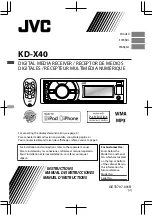
D14636.13 Profile C60-C40 and Codec C60-C40 Administrator Guide TC7.0, DECEMBER 2013.
www.cisco.com — Copyright © 2010-2013 Cisco Systems, Inc. All rights reserved.
102
Cisco TelePresence System Codec C40/C60 and Profiles using C40/60
Administrator Guide
SIP Profile [1..1] Outbound
Turn on or off the client initiated connections mechanism for firewall traversal, connection reuse
and redundancy. The current version supports RFC 5626.
Requires user role:
ADMIN
Value space:
<Off/On>
Off:
Connect to the single proxy configured first in Proxy Address list.
On:
Set up multiple outbound connections to servers in the Proxy Address list.
Example:
SIP Profile 1 Outbound: Off
SIP Profile [1..1] Proxy [1..4] Address
The Proxy Address is the manually configured address for the outbound proxy. It is possible to
use a fully qualified domain name, or an IP address. The default port is 5060 for TCP and UDP
but another one can be provided. If SIP Profile Outbound is enabled, multiple proxies can be
addressed.
Requires user role:
ADMIN
Value space:
<S: 0, 255>
Format:
A valid IPv4 address, IPv6 address or DNS name.
Example:
SIP Profile 1 Proxy 1 Address: ""
SIP Profile [1..1] Proxy [1..4] Discovery
Select if the SIP Proxy address is to be obtained manually or by using Dynamic Host
Configuration Protocol (DHCP).
Requires user role:
ADMIN
Value space:
<Auto/Manual>
Auto:
When Auto is selected, the SIP Proxy address is obtained using Dynamic Host
Configuration Protocol (DHCP).
Manual:
When Manual is selected, the manually configured SIP Proxy address will be used.
Example:
SIP Profile 1 Proxy 1 Discovery: Manual
SIP Profile [1..1] Type
Enables SIP extensions and special behaviour for a vendor or provider.
NOTE: The SIP types Alcatel, Avaya, Microsoft, and Nortel are no longer supported from
software version TC6.3.
Requires user role:
ADMIN
Value space:
<Standard/Cisco>
Standard:
Use this when registering to standard SIP Proxy (tested with Cisco TelePresence
VCS and Broadsoft)
Cisco:
Use this when registering to Cisco Unified Communication Manager.
Example:
SIP Profile 1 Type: Standard
SIP Profile [1..1] Mailbox
When registered to a Cisco Unified Communications Manager (CUCM) you may be offered
the option of having a private voice mailbox. Enter the number (address) of the mailbox in this
setting, or leave the string empty if you do not have a voice mailbox.
Requires user role:
ADMIN
Value space:
<S: 0, 255>>
Format:
String with a maximum of 255 characters.
Example:
SIP Profile 1 Mailbox: "12345678"
SIP Profile [1..1] Line
When registered to a Cisco Unified Communications Manager (CUCM) the endpoint may be
part of a shared line. This means that several devices share the same directory number. The
different devices sharing the same number receive status from the other appearances on the
line as defined in RFC 4235.
Note that shared lines are set up by CUCM, not by the endpoint. Therefore do not change this
setting manually; CUCM pushes this information to the endpoint when required.
Requires user role:
ADMIN
Value space:
<Private/Shared>
Shared:
The system is part of a shared line and is therefore sharing its directory number with
other devices.
Private:
This system is not part of a shared line (default).
Example:
SIP Profile 1 Line: Private
Contents
Introduction
Web interface
System settings
Setting passwords
Appendices
System settings















































